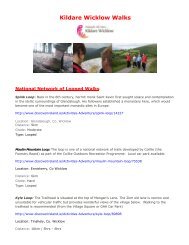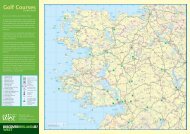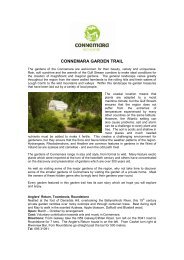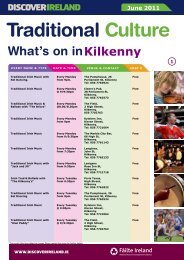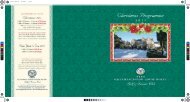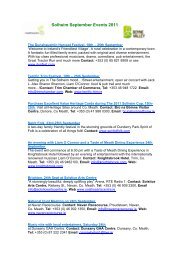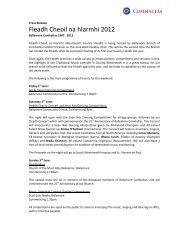Free Guide - Discover Ireland
Free Guide - Discover Ireland
Free Guide - Discover Ireland
You also want an ePaper? Increase the reach of your titles
YUMPU automatically turns print PDFs into web optimized ePapers that Google loves.
* An Artist Impression, as it might have looked in its heyday, illustration by Uto Hogerzeil<br />
Rath na Rí (The Fort of the Kings), Teach<br />
Cormaic (Cormac’s House), Rath Gráinne<br />
(The Fort of Gráinne), Rath na Seanadh<br />
(The Rath of the Synods) and Claoin<br />
Fhearta (The Sloping Trenches).<br />
Although Tara was finally abandoned by<br />
Mael Shechlainn, High King of <strong>Ireland</strong>, in<br />
1022 it continued to play an important<br />
symbolic role in Irish history into the<br />
modern period. In 1843 an estimated<br />
one million people gathered there to hear<br />
Daniel ‘The Liberator’ O’Connell speak<br />
against the Union of Great Britain and<br />
<strong>Ireland</strong>. In 1902, in a letter to the Editor of<br />
The Times, Tara was described by Douglas<br />
Hyde, George Moore and William Butler<br />
Yeats, key figures in the Gaelic Revival, as<br />
‘the most consecrated spot in <strong>Ireland</strong>’.<br />
Did you know … A group of British Israelites<br />
nearly destroyed Rath na Seanadh (The<br />
Rath of the Synods) between 1899<br />
and 1902. They believed the Ark of the<br />
Covenant was buried there.<br />
Contact Details:<br />
Hill of Tara, Tara, Navan, Co. Meath<br />
GPS: 53° 34’ 52.68”, -6° 36’ 32.04”<br />
T & F: + 353 (0) 46 902 5903<br />
E: hilloftara@opw.ie<br />
W: www.heritageireland.ie<br />
FOR OPENING TIMES AND ADMISSION DETAILS PLEASE SEE PULL OUT INSERT AT THE BACK 27



